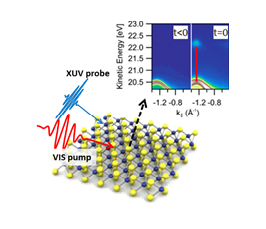Electronic and Structural Dynamics in Solids: A Momentum-Resolved View on Microscopic Coupling and Correlation Phenomena
MPSD Seminar
- Datum: 07.07.2016
- Uhrzeit: 14:00 - 15:00
- Vortragende(r): Ralph Ernstorfer
- Max Planck Research Group for Structural & Electronic Surface Dynamics, Fritz-Haber-Institut der Max-Planck-Gesellschaft, Berlin, Germany
- Ort: CFEL (Bldg. 99)
- Raum: Seminar Room I-III, EG.076-080
- Gastgeber: Angel Rubio

We employ a set of complementary techniques: i) time- and angle-resolved photoelectron spectroscopy (trARPES) based on a 0.5 MHz laser [1] generating XUV pulses provides access to the spectral function and the dynamics of excited states throughout the Brillouin zone; ii) femtosecond electron diffraction (FED) [2] and optical spectroscopy are used to study phonon dynamics [3] and phase transitions [4]; and iii) electron point-projection microscopy allows for imaging of ultrafast carrier transport in nanostructures [5].
In particular, I will
discuss electron and phonon dynamics in the semiconducting transition
metal dichalcogenide WSe2. We demonstrate mapping of the conduction band and the generation of spin- and pseudospin-polarized excited states in
this centrosymmetric material [6]. A momentum-resolved view of the
phonon dynamics is obtained from by FED.
[1] M. Puppin et al., Opt. Exp. 23 1491-1497 (2015).
[2] L. Waldecker et al., J. Appl. Phys. 117, 044903 (2015).
[3] L. Waldecker et al., Phys. Rev. X 6, 021003 (2016).
[4] L. Waldecker et al., Nature Materials 14, 991 (2015).
[5] M. Müller et al., Nature Communications 5, 5292 (2014); M. Müller et al., ACS Photonics 3, 611 (2016).
[6] R. Bertoni et al., arXiv:1606.03218.